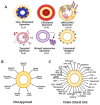Nanoparticles in Clinical Translation for Cancer Therapy
- PMID: 35163607
- PMCID: PMC8835852
- DOI: 10.3390/ijms23031685
Nanoparticles in Clinical Translation for Cancer Therapy
Abstract
The advent of cancer therapeutics brought a paradigm shift from conventional therapy to precision medicine. The new therapeutic modalities accomplished through the properties of nanomaterials have extended their scope in cancer therapy beyond conventional drug delivery. Nanoparticles can be channeled in cancer therapy to encapsulate active pharmaceutical ingredients and deliver them to the tumor site in a more efficient manner. This review enumerates various types of nanoparticles that have entered clinical trials for cancer treatment. The obstacles in the journey of nanodrug from clinic to market are reviewed. Furthermore, the latest developments in using nanoparticles in cancer therapy are also highlighted.
Keywords: cancer therapy; nanochemotherapy; nanodrugs; nanomedicine; nanoparticles.
Conflict of interest statement
The authors declare no conflict of interest.
Figures






References
-
- Hassan H.A.F.M., Smyth L., Wang J.T.-W., Costa P.M., Ratnasothy K., Diebold S.S., Lombardi G., Al-Jamal K.T. Dual stimulation of antigen presenting cells using carbon nanotube-based vaccine delivery system for cancer immunotherapy. Biomaterials. 2016;104:310–322. doi: 10.1016/j.biomaterials.2016.07.005. - DOI - PMC - PubMed
Publication types
MeSH terms
LinkOut - more resources
Full Text Sources
Other Literature Sources
Medical

